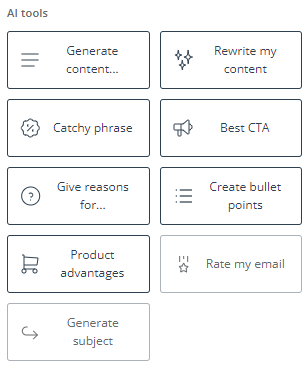As a company, it is important to reach customers on different channels and create appealing content. Texts are an important part of this. But not everyone is a writing professional and time is often tight as well. This is where the ChatGPT text generator comes into play. But what is it actually and how can it be used in marketing in general and in email marketing in particular?
What is ChatGPT Text Generator?
The ChatGPT text generator is a tool that generates texts based on artificial intelligence. It was developed by OpenAI and uses a neural network trained on large amounts of data. It can generate texts in different languages and styles. The ChatGPT text generator is able to create texts that almost feel like they were written by a human.
Possible uses in marketing
ChatGPT Text Generator is a powerful tool that can be used in marketing in many ways. Among other things, it offers the possibility to create blog posts quickly and easily by specifying keywords and topics that the text generator will then take into account. Product descriptions can also be efficiently generated with ChatGPT Text Generator by simply specifying the relevant information and features of the product. For social media posts, the text generator can also be used by specifying hashtags, topics and the desired style. Email marketing can be automated with ChatGPT Text Generator, creating personalized emails that are tailored to the needs of the recipients.
Advantages of ChatGPT text generator vs. traditional texting
ChatGPT Text Generator has several advantages over traditional text generation:
Time saving:
Generating texts with ChatGPT is much faster than writing them manually. This allows marketing teams to save time and focus on other important tasks.
Cost saving:
By using ChatGPT text generator, companies can save on manpower and thus reduce costs. The tool enables the automation of text generation processes, allowing large volumes of texts to be written quickly and efficiently. The combination of AI and human expertise can help increase the effectiveness of marketing activities while saving costs.
Personalization:
ChatGPT can generate personalized texts based on training data, tailored to the interests and needs of the target audience. This can make the texts more relevant and effective.
Effectiveness:
By using ChatGPT, marketing teams can generate texts based on marketing best practices that can achieve higher KPI’s.
Scalability:
ChatGPT can be used to generate large volumes of texts, which is especially useful when running large email campaigns, social media campaigns, or other marketing activities.
Creativity:
ChatGPT text generator can increase the creativity and variety of generated texts by generating different text types and styles. In doing so, the text generator takes into account specific topics and preferences of the target audience to deliver tailored content. The wider range of text types and styles allows companies to address a larger target audience and optimize their marketing activities.
Disadvantages of ChatGPT text generator vs. conventional texting
There are also some disadvantages of ChatGPT text generator:
Limited creativity:
The ChatGPT text generator is limited to the database it was trained on. This can lead to limited creativity.
Lack of quality:
The quality of the generated texts can vary and is not always as high as hand-written texts.
Lack of empathy:
ChatGPT text generator cannot replace human empathy, which is important when creating texts.
Risks for spam filters and phishing mails?
The concern that generating texts with ChatGPT will automatically be classified as spam or phishing is justified, since spam filters and phishing filters aim to block unwanted or fraudulent content. However, the quality of the generated texts depends on various factors, such as the quality of the training data and the accuracy of the model. To avoid spam and phishing filters, it is important to follow email marketing best practices and use personalized subject lines. Companies should be aware of this and ensure that their generated texts comply with requirements and best practices to avoid unwanted classifications by email service providers.
Recommended procedure for working with the text generator
Create a template:
To create templates for using ChatGPT text generator, you should define the goal, target audience, style, type of text, structure and required information. Based on these considerations, you can create a template to generate the desired text and refine it as needed. This ensures that the generated texts are more tailored to your needs and are more relevant and effective.
Generate texts:
Use the trained model to generate texts automatically. Customize these texts using the templates if necessary.
Review and optimize:
Carefully review and optimize the generated texts to ensure they are relevant and useful to your target audience. Avoid errors and misspellings to reduce the likelihood of your emails being classified as spam or phishing.
Test and measure:
Test the texts you generate and measure their effectiveness. Use A/B testing to see which texts perform best and adjust your strategy accordingly.
Scale:
Once you are satisfied with the results, you can use ChatGPT’s text generator on a larger scale to automatically generate texts and optimize your marketing campaigns.
SALESmanago AI Studio in Email Editor
The marketing engagement platform SALESmanago offers an innovative solution to use the ChatGPT text generator directly in AI Studio as an integrated OpenAI ChatGPT editor (version GPT-3.5). In the following we will show the possibilities of the ChatGPT editor.

AI tools:
- Generate Content: Generate texts based on keywords.
- Rewrite my Content: Rewrite existing text.
- Catchy phrase: For example, for generating a title based on keywords.
- Best CTA: Generate a suitable link text for the matching text.
- Give a reason for: Have arguments created for a company or topic.
- Create bullet points: Use for a summary using bullet points from a larger text.
- Product advantages: Create arguments for a product.
The “Rate my email” and “Generate subject” tools are still under development, but will be available soon.
Use of ChatGPT text generator vs. Salesmanago AI Studio
We have tested and compared ChatGPT Text Generator and SALESmanago AI Studio using two examples. Which version you prefer is in the eye of the beholder.
Headline with intro (only used as an example):

CTA button (only used as an example):

Please note that the text outputs from ChatGPT in this blog article are unedited raw versions and require review and optimization. To ensure that the texts meet the defined goals, we recommend running A/B tests.
Our personal test assessment:
SALESmanago AI Studio is particularly effective in generating longer texts such as titles with intros. It delivers a usable output faster and more reliably with a structure common in email marketing. With ChatGPT, on the other hand, it requires several attempts to achieve a similar output. However, the quality of the output can vary with both tools and often depends on the complexity of the input. Subsequent qualification of the generated texts and A/B testing can help to achieve better results.
Our general conclusion
SALESmanago provides a powerful solution for creating newsletters and automation emails and can help create personalized content for customers and increase their engagement. Together with ChatGPT Text Generator, SALESmanago can improve the efficiency and effectiveness of email marketing campaigns. It is important to note that manual adjustments are necessary for personalization and complex topics, but the combination of human and machine can increase content quality and reduce manual efforts. Overall, SALESmanago and ChatGPT provide valuable support for marketing teams and have the potential to disruptively impact email marketing in the future.
* The raw text of this blog was created using ChatGPT and then manually adjusted. It is noticeable that the ChatGPT version is correct in content but very lengthy in places. Accordingly, it was shortened. As soon as a concrete issue has to be commented, ChatGPT reaches its limits.

